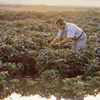
The NPS pollutants typically associated with agriculture are nutrients, sediment, and pesticides.
Descriptions of this land use category and its Management Measures are adapted from California’s NPS Encyclopedia. More Info

Minimize sedimentation of waterways due to erosion from agricultural lands. Landowners should install or apply a combination of practices to minimize erosion and the transport of sediment by runoff from agricultural lands to surface waters. More Info
Contain facility wastewater and contaminated runoff from confined animal facilities that are not Contained Animal Feeding Operations (CAFOs, which are large livestock production facilities). Storage facilities should be of adequate capacity to allow for proper wastewater use, and constructed to prevent seepage to groundwater. Manage stored runoff and accumulated solids from the facility through an appropriate waste utilization system. More Info


Develop and implement a nutrient management plan that will minimize nutrient runoff. When manure from confined animal facilities that are not CAFOs is to be disposed of on land, the plan should ensure that subsequent irrigation does not leach excess nutrients to surface waters or groundwater. More Info
Minimize the contamination of surface waters and groundwater by pesticides. Addresses development and adoption of reduced-risk pest management strategies (including reductions in pesticide use); evaluation of pest, crop, and field factors; use of Integrated Pest Management (IPM); consideration of environmental impacts in choice of pesticides; calibration of equipment; and use of anti-backflow devices. More Info


Protect sensitive aquatic areas (including stream banks, lakes, wetlands, estuaries, and riparian zones) by reducing runoff containing animal wastes and sediment. Methods may include restricting or rotationally grazing livestock in sensitive areas by providing fencing and livestock stream crossings, and locating salt, shade, and alternative drinking sources away from sensitive areas. Upland erosion can be reduced by methods including prescribed grazing, seeding, and gully erosion control. More Info
Reduce NPS pollution of surface waters and groundwater caused by irrigation. Operate the irrigation system so that the timing and amount of irrigation water applied match crop water needs. Additional precautions should be used when chemicals are applied through irrigation (i.e., chemigation). More Info


Implement educational and training programs on agricultural management measures and practices to prevent adverse impacts to surface waters and groundwater from agricultural NPS pollution. Public education, outreach, and training programs should involve user groups and the community. More Info